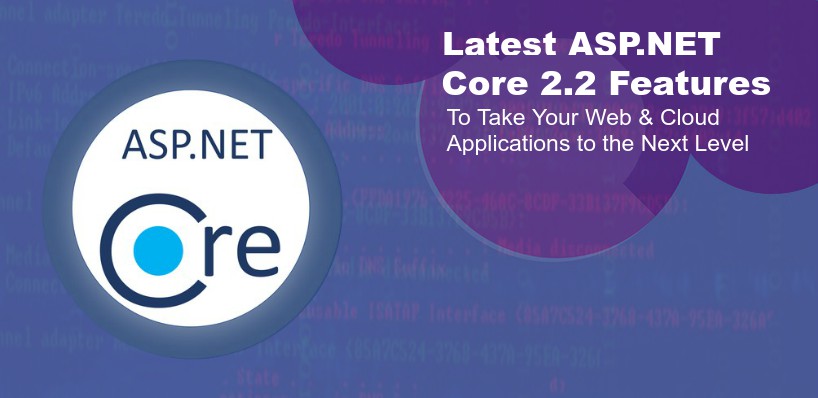ASP.NET Core employs open-source technology with a cross-platform framework. With its help, ASP.NET developers to create highly scalable and performance-oriented web applications. Here, in this write-up, we will divert our attention to some of the latest features in ASP.NET Core 2.2 that can take your web and cloud applications to the next level of success.
The great news is that it contains the most up to date versions of web pages, .NET MVC, Web API, and SignalR that can be employed to work independently in the same application. This very reason makes ASP.NET Core as the next generation development platform.
In the forthcoming sections of this write-up, we will look at the latest ASP.NET Core 2.2 features that take your ASP.NET web development to the next level of success. We promise after reading this piece of content; you will be in a far better position to understand the significance of ASP.NET in the development field.
Let’s dive into the features right away.
Cross-Platform Functionality
When it comes to Linux, Unix systems, or Mac OS, the .NET Core represents the best choice. The reason being, it now gives developers the liberty to deploy cutting-edge technology like Microsoft Azure, Kubernetes, Docker, and others with ASP.NET Core. On top of this, the .NET Core SDK comprises of a wide array of command-line tools that can be utilized to create, publish, build, and compile the .NET Core application on any operating system.
Better Performance
ASP.NET Core is an advanced version of the classic ASP.NET. It has been assured by the Microsoft team that it performs much better in terms of the latest technologies when utilized in microservices, including Java servlet, Node.js, and Go. Compression, concurrency, networking, serialization, which are quite common in the age of Web APIs, perform much quicker with .NET Core.
It boosts the performance to another level. According to prominent research, it has been found that the ASP.NET Core application can handle 1.15 million requests per second, which is 2300% more than ASP.NET 4.6.
Combination of Development Models
You will be glad to know that MVC and Web API development models work in a unified manner. They are employed using identical base class Controller. With its help, the controller gets exposed to Web Service features and HTML (View).
MVC model of ASP.NET Core helps in creating web applications and web APIs that are testable. On top of this, it also provides built-in support for multiple data formats. Content negotiation assists Web APIs to transform into application for different platforms like browsers and mobile devices.
Brand New Health Checks API
ASP.NET Core 2 new features use a brand new health checks API that is nothing but a set of libraries that comes in handy to define an abstraction and a middleware. The BeatPulse project launched by Microsoft comes in full support of the new Health Checks API.
In the past, this feature was missing in the ASP.NET Core ecosystem. This is great news for developers. The reason being, they can now effortlessly integrate health checks for different dependencies and systems using them.
In-built Dependency Injection
Dependency injection has always been the base of the development issues. The reason being, it enables better code testability and weak coupling. There is a brand new architecture that has been integrated that relates to the dependency injection. The modularity and flexibility of ASP.NET Core are contingent on dependency injection, which is now an integral feature of ASP.NET Core. Since ASP.NET executes the management of dependency injection natively, developers will no longer have to depend on third-party tools to get the desired results.
SignalR Java Client
This is yet another latest feature that has been included in ASP.NET Core. Java client for SignalR is nothing but a library of ASP.NET that enables server code to assign asynchronous notifications to the client-side web applications. Thanks to the integration with Java client, it is possible to get support for connection from Java Code to the SignalR Server that includes Android apps.
Self-Hosted Web Apps
It is no longer mandatory for ASP.NET Core applications to need IIS for hosting. You can self-host it or host it on Nginx for Linux distributions. The major reason for this is to ensure that a .NET Core application is launched independently across all platforms. Even while in production, IIS (or Nginx) is a reverse proxy for the self-hosted application.
Minimal Code Requirement
ASP.NET Core executes several prevalent APIs with the .NET Framework on top of APIs related to OS X, Linux, and Unix. Common APIs are grouped in .NET Standard, which is executed by both .NET Core and .NET Framework. In layman’s terms, it means that any code that is targeted towards .NET standard can be run on .NET Core and .NET Framework. This way, it becomes effortless to share code between the two platforms.
Razor Pages
This is yet another new feature in ASP.NET Core 2.0. With the help of Razor Pages, it is possible to enable the Startup class through dependency injection. These new pages allow the execution of independent views of controllers and ensure that the development of scenarios more fluid on top of clarifying the architecture of your solution.
Swagger Open APIs
Swagger is considered to be one of the most prevalent technologies for describing and designing RESTful APIs. Through its use, developers can effortlessly document and develop APIs while also maintaining synchronization with the code.
Effortless Compilation
This is the best feature that has been integrated into ASP.NET Core 2.2. As soon as the code alterations get saved, a simple refresh of the browser enables the activation of the compilation.
Final Thoughts
These are the latest ASP.NET Core 2.2 features that can take your web and cloud applications to the next level of success. If you wish to take advantage of this latest update, affiliate with a reputed ASP.NET development company and avail their ingenious ASP.NET application development services to develop high-end web and cloud applications.
